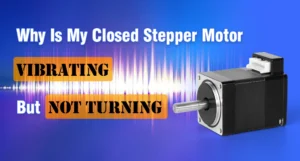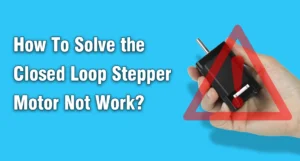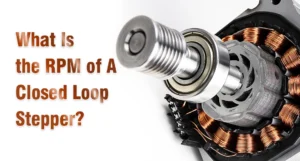Closed loop stepper motors have gained popularity in various applications due to their ability to combine the precision of stepper motors with the feedback control of servo systems. However, like any technology, closed-loop stepper motors are not immune to issues.
In this blog, MXELECTRON will explore some common problems associated with closed-loop stepper motors and provide practical solutions to address them.
-
Closed Loop Stepper Motor Overheating Issues
Problem: Closed loop stepper motors can overheat, leading to reduced performance and potential damage to the motor.
Solution: Check the current settings: Adjust the motor current to match the manufacturer’s recommendations. Overdriving the motor can result in overheating.
Enhance cooling: Install additional cooling mechanisms such as fans or heat sinks to dissipate heat effectively.
Monitor ambient temperature: Ensure that the operating environment remains within the specified temperature range for the motor.

-
Communication Failures
Problem: Communication errors between the controller and the motor can occur, leading to erratic movements or motor malfunctions.
Solution: Check cables and connections: Inspect all cables and connectors for damage or loose connections. Replace faulty components.
Verify communication settings: Ensure that the communication parameters (baud rate, parity, etc.) are correctly configured in both the controller and the motor.
-
Loss of Steps
Problem: Closed-loop stepper motors may experience a loss of steps, resulting in inaccurate positioning.
Solution: Increase current levels: Insufficient current can cause a loss of steps. Adjust the current settings to meet the motor’s requirements.
Reduce load: If the motor consistently loses steps, consider reducing the load or using a motor with a higher torque rating.
Check for mechanical issues: Examine the mechanical components, such as couplings and lead screws, for wear or damage.
-
Vibration and Noise
Problem: Excessive vibration and noise during motor operation can impact system performance and lead to wear and tear.
Solution: Fine-tune acceleration and deceleration settings: Adjust acceleration and deceleration parameters to minimize sudden speed changes, reducing vibration.
Upgrade to a higher resolution encoder: A higher resolution encoder can improve the motor’s ability to control and minimize vibrations.
Ensure proper mechanical alignment: Misalignment of mechanical components can contribute to vibrations. Align all components correctly.
-
Faulty Feedback System
Problem: Issues with the feedback system, such as the encoder or resolver, can result in inaccurate position control.
Solution: Calibrate the feedback system: Regularly calibrate the feedback system to ensure accurate position information.
Inspect and clean encoders: Dust or debris can interfere with encoder signals. Regularly clean and inspect the encoder for optimal performance.

-
Inadequate Power Supply
Problem: Inconsistent or insufficient power supply can lead to erratic motor behavior, including stalling and loss of control.
Solution: Check power supply specifications: Ensure that the power supply meets the motor’s voltage and current requirements. Use a high-quality power supply with stable output.
Monitor voltage fluctuations: Install voltage regulators or stabilizers to minimize the impact of voltage fluctuations on the motor.
-
Software Configuration Issues
Problem: Incorrect software settings or firmware configurations can result in unexpected motor behavior.
Solution: Update firmware: Regularly check for firmware updates from the motor and controller manufacturers. Apply updates to benefit from bug fixes and performance improvements.
Verify software parameters: Double-check the software settings, including microstepping, acceleration, and velocity profiles, to match the motor’s specifications.
-
Environmental Contamination
Problem: Dust, moisture, or other contaminants can affect the motor’s performance over time.
Solution: Implement protective measures: Enclose the motor in a protective casing to shield it from environmental contaminants.
Regular cleaning: Perform routine maintenance to clean dust and debris from the motor and surrounding components.

-
Mechanical Resonance
Problem: Mechanical resonance can occur when the motor’s natural frequency matches the frequency of external forces, resulting in vibrations and reduced performance.
Solution: Change operating speed: Adjust the operating speed to avoid resonance frequencies.
Use dampers: Install dampers or shock absorbers to minimize the impact of vibrations on the motor and the connected load.
-
Insufficient Motor Torque
Problem: In some cases, the motor may not have enough torque to overcome the load, leading to issues like stalling.
Solution: Choose a higher torque motor: Consider using a stepper motor with a higher torque rating if the application demands more torque.
Optimize mechanical efficiency: Ensure that mechanical components, such as couplings and gearboxes, are properly lubricated and aligned for optimal efficiency.
Conclusion
Closed loop stepper motors represent a sophisticated solution for precise motion control, but addressing potential issues requires a systematic approach. Regular maintenance, attention to environmental factors, and a thorough understanding of the motor’s specifications are essential for ensuring consistent and reliable performance. By implementing the suggested solutions and staying proactive in monitoring and adjusting system parameters, users can harness the full potential of closed loop stepper motors in their applications.
Contact MXELECTRON if you have any ideas!





